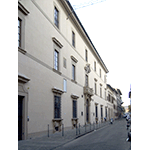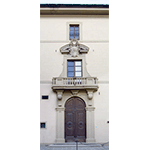Della Gherardesca Garden
The garden’s original layout dates back to the construction of Bartolomeo Scala’s palazzo, built on a project by Giuliano da Sangallo between 1472 and 1480. Cited by sources as one of the finest gardens of Florence, at the end of the 16th century the property entered the possession of cardinal Alessandro de’ Medici, followed by his sister Costanza who married a Della Gherardesca. With its classical layout, the garden was divided into a vegetable garden, a vivarium and a trammel-net (originally property of the Wool Merchants’ Guild).
Count Guido Alberto Della Gherardesca gave the garden an English arrangement, creating footpaths, an artificial lake and a plantation of high-trunk trees of rare species, several of which can still be seen, including a large maple, a sequoia and a Tassus Baccata, the most impressive plant in the garden. The numerous botanical rarities included the first mandarin orange trees, recalled by Antonio Targioni Tozzetti, which were in 1844 the first cultivated in Florence. In the course of remodelling the garden, several small buildings were created, including a small Ionic temple and a kaffeehaus, on projects by Giuseppe Cacialli, and a tepidarium with a statue of Count Camillo, to recall the reclamation of Maremma. In 1857, the garden hosted the fourth Exhibition of the Tuscan Society of Horticulture.
Becoming property of the Societą Metallurgica Italiana [Italian Metallurgical Society] after World War II, it was subjected to rehabilitation by Piero Porcinai, which restored it to its former splendour.
****************************
Texts by Graziano Magrini
English translation by Victor Beard
Last update 16/gen/2008





